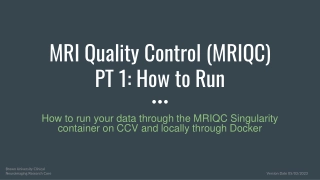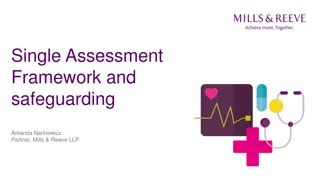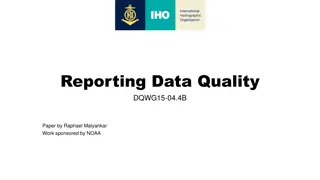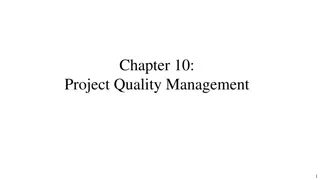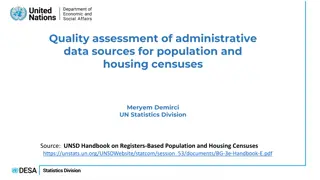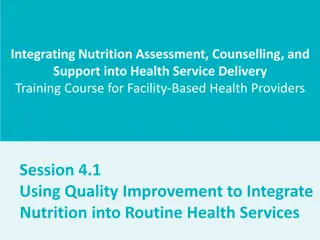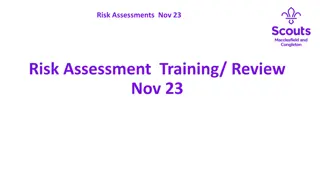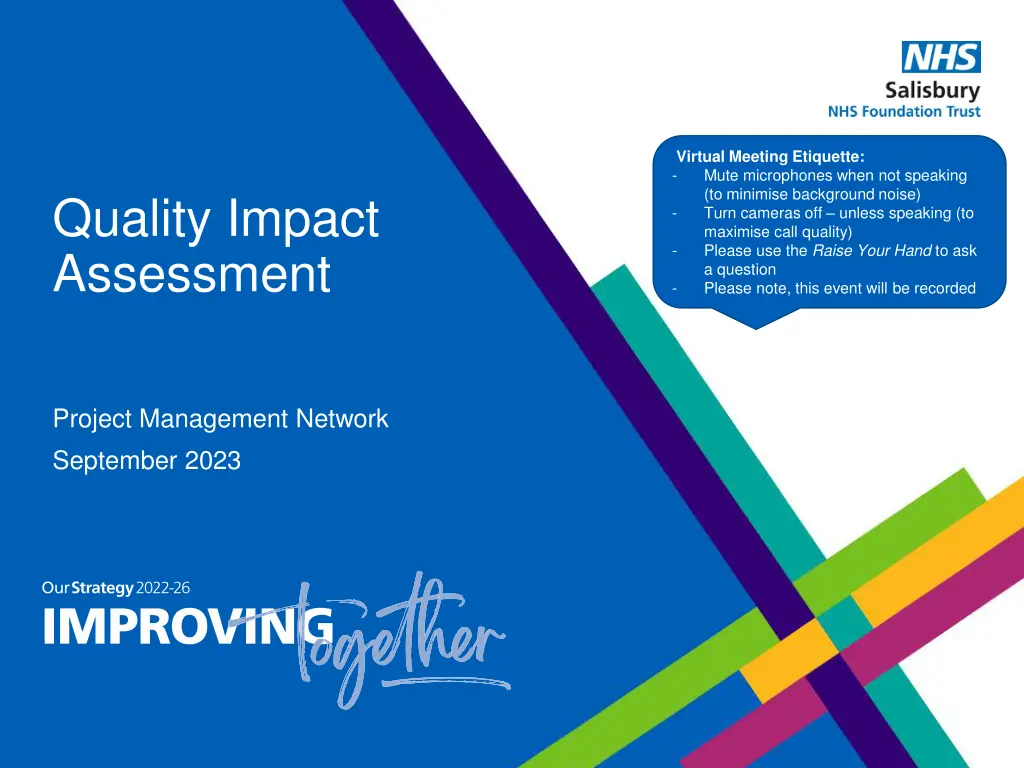
Quality Impact Assessment in Project Management - Importance and Implementation
Discover the significance of Quality Impact Assessments (QIAs) in project management, why they are crucial, when and how to conduct them, and their relevance to risk assessment. Learn the impact of QIAs on patient safety, clinical effectiveness, patient experience, and equality and inclusion.
Download Presentation

Please find below an Image/Link to download the presentation.
The content on the website is provided AS IS for your information and personal use only. It may not be sold, licensed, or shared on other websites without obtaining consent from the author. If you encounter any issues during the download, it is possible that the publisher has removed the file from their server.
You are allowed to download the files provided on this website for personal or commercial use, subject to the condition that they are used lawfully. All files are the property of their respective owners.
The content on the website is provided AS IS for your information and personal use only. It may not be sold, licensed, or shared on other websites without obtaining consent from the author.
E N D
Presentation Transcript
Virtual Meeting Etiquette: - Mute microphones when not speaking (to minimise background noise) - Turn cameras off unless speaking (to maximise call quality) - Please use the Raise Your Hand to ask a question - Please note, this event will be recorded Quality Impact Assessment Project Management Network September 2023
Overview of Session 1. What is a Quality Impact Assessment (QIA) 2. Why are QIAs important 3. When & how should I complete a QIA 4. What happens to a QIA once completed 5. Q & A - discussion 6. Closing questions
What is a Quality Impact Assessment? A Quality Impact Assessment (QIA) is a tool that assesses the impact of new plans, programmes, projects and savings schemes on quality. It supports quality governance by assessing the impact on quality to inform and enable appropriate decision-making. It provides the opportunity to stop the change before it takes place if the risk is deemed too high Quality; 1. Risk to patient safety 2. Risk to clinical effectiveness 3. Risk to patient experience 4. Impact on Equality & Inclusion
Why is a Quality Impact Assessment important? The need for a formal QIA process was a direct result of the Francis Inquiry Report published in February 2013 which examined the causes of the failings in care at Mid Staffordshire NHS Trust between 2005 2009 Their focus on cost containment and improving efficiency (without due regard for the impact on service provision) was seen as one of the key drivers for the resultant poor care experienced by so many patients Sir Robert Francis QC
When should I complete a QIA? A QIA should be completed during the planning phase of your change and definitely before you make the change! It forms part of the planning process assesses the theoretical impact of the change and helps you as leaders of change ensure your project or improvement includes actions to mitigate any possible impact.
How does this fit with the risk assessment process? If you answer no to the first question as to whether this is a planned change then you should complete a risk assessment & mitigate/manage the risk in line with Risk Policy The sorts of changes you might make which are unplanned in nature are time sensitive changes which are needed to mitigate an immediate risk of harm
How do I complete a QIA? Good practice is for a QIA to be clinically led but completing as a stakeholder group/project team with the lead clinician is best practice Should start with describing the overall change be clear about the key components of the change how might patients experience or interact with the service differently, what might staff be doing that is different Example; Up to 26 patients with NCTR (no criteria to reside) will be moved to be cared for in South Newton Hospital in two ward areas for a period of up to 8 weeks under the SFT registration. This is to allow Breamore Ward to be emptied to allow for some urgent essential maintenance. The patients will be cared for by SFT staff and due diligence will be taken to ensure that all services that are not provided directly by SFT are subject to the level of scrutiny that provides SFT with assurance.
How do I complete a QIA? First Step is to complete a rapid impact assessment 4 key questions Rapid Assessment Is the scheme going to impact on the workforce? Is the scheme going to impact on the way the service is delivered? Is the financial benefit over 50k? Does the initial risk review for the overall project score 8 or above ?(circle risk score on matrix to the Right)
How do I complete a QIA? If you answer to any one of the key questions is yes or the risk score is 8 or above, you need to move onto a full QIA. SCORE EACH RISKS LISTED Impact Details INDICATORS (include mitigation/control - do these measures address the risk? You should assess each pillar of quality (Add more rows as required so each impact is individually stated) Consequence Likelihood Score Does the planned change have the potential to impact on the saftey of patients, staff or any other person? Risks: Risks to Patient Safety 1 3 3 Mitigation: Use coaching questions, appreciative enquiry, be curious! Have clinicians been involved in developing the planned change? Is there evidence to support the change (case studies, best partice, NICE guidelines etc.)? Risks: Risk to Clinical Effectiveness 4 5 20 Mitigation: Ask the what if this happens, how might patients experience that difference to now, what benefits are there as well as risks Consider healthcare environment, dignity and respect of patients, families and carers etc. waiting times, access to services, equality and diversity Risks: Risk to Patient Experience 2 4 8 Mitigation: Consider whether the change affects one or more equality target group(s) in a different way to other groups? Could or do different equality groups have different needs in relation to the planned change? Does the planned change actually or potentially contribute to or hinder equality of opportunity? Does the planned change offer opportunities to promote equality & inclusion? Risks: Equality & Inclusion 2 4 8 Mitigation: What changes are needed to mitigate Equality Impact Assessment guidance and form (All planned changes should complete a more detailed Equality Impact Assessment at this link) Overall risk score: 20 QIAs with a score of >12 must be added to the Divisional Risk Register Datix reference:
Useful QIA checklist: The following is a useful checklist for consideration when carrying out the QIA: Patient Safety Impact on patient safety? Impact on preventable harm? What is the impact on partner organisations and any aspect of shared risk? Will this impact on the organisation s duty to protect children, young people and adults? Will it affect the reliability of safety systems? How will it impact on systems and processes for ensuring that the risk of healthcare acquired infections to patients is reduced? What is the impact on clinical workforce capability care and skills? Clinical Effectiveness How does it impact on implementation of evidence based practice? How will it impact on clinical leadership? Does it reduce/impact on variation in care provision? Does it affect supporting people to stay well? Does it promote self-care for people with long term conditions? Does it impact on ensuring that care is delivered in most clinically and cost effective setting? Does it eliminate inefficiency and waste by design? Does it lead to improvements in care pathway? Patient Experience What is the impact on race, gender, age, disability, sexual orientation, religion and belief for individual and community health, access to services and experience? What impact is it likely to have on self-reported experience of patients and service uses? (Response to national/local surveys/complaints/Customer Care/incidents) How will it impact on the choice agenda? How will it impact on the compassionate and personalised care agenda? Equality & Inclusion Consider whether the change affects one or more equality target group(s) in a different way to other groups? Could or do different equality groups have different needs in relation to the planned change? Does the planned change actually or potentially contribute to or hinder equality of opportunity? Does the planned change offer opportunities to promote equality & inclusion?
Example From Same Day Emergency Care (SDEC) QIA To provide medical Same Day Emergency Care (SDEC) from 08:00 to 20:00, 7 days per week, integrated into AMU. Increased Day 0 discharges to 33% leading to a reduction in bed days Patient Safety: the removal of 6 escalation beds from the Trust bed base may result in worse flow through the hospital and potentially increase the wait in ED for a downstream medical bed. This may cause a delay in assessment in ED and increase time to ambulance handover. Mitigation: reducing beds but maintaining same levels of medical staffing to enable timely assessment and flow from ED. KPI: Active Monitoring of wait times, assessment times Clinical Effectiveness: Initial change to logistics of how patients are reviewed within the AMU MDT may result in a slower service, as staff adapt to the changes. The new model may be confusing for staff and will take some time to bed in. Mitigation: Good evidenced model of practice; senior clinicians experienced in the model would supervise the new way of work KPI: Time taken to review the patient in line with target assessment times
How do I complete a QIA? You must include your Key Quality Indicators (KQIs) Ensure any quality indicator is measurable Can be directly linked to the schemes performance or the changes proposed. You will rely on this section to ensure you have active monitoring in place during implementation And when completing the 6 month review to be able to measure the impact the scheme has had and provide assurance that your mitigations have minimised any adverse or risk to harm. Average LOS hours - Pre Trial 33 hours SDEC Pilot 22 Hours Reduction 11 hours Time to Junior Doctor Assessment - Pre Trial 161 Mins SDEC Pilot 99 Mins Reduction 62 Mins Time to 14-hour Consultant review - Pre Trial 453 Mins SDEC Pilot 382 Mins Reduction 71 Mins Number of NEL Admissions - Pre Trial 215 SDEC Pilot 183 Reduction 32 % 0 Day LOS - Pre Trial 20.2% SDEC Pilot 34.7% - Increase 14.5 points
Ongoing monitoring of Quality Impact Assessment? - Providing confirmation that there is governance in place to monitor the change and ensure quality is not impacted adversely. - A 6 month follow up to formally assess impact.
QIA location on project and programmes site on microguide qia-template-and-process-sft-final- april-23.xlsx (live.com)
Breakout groups and Q&A 1. What changes are you making now that might need a QIA? 2. Do you now feel confident to do that? 3. What other questions might you still have about QIA? Please ask one person to summarise any reflections, thoughts, questions you have when you return to the main group.


